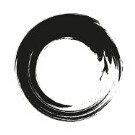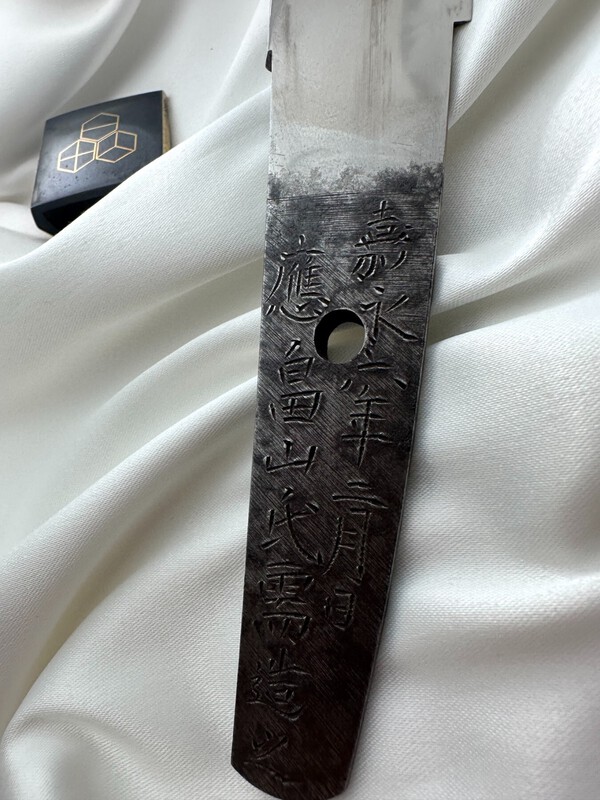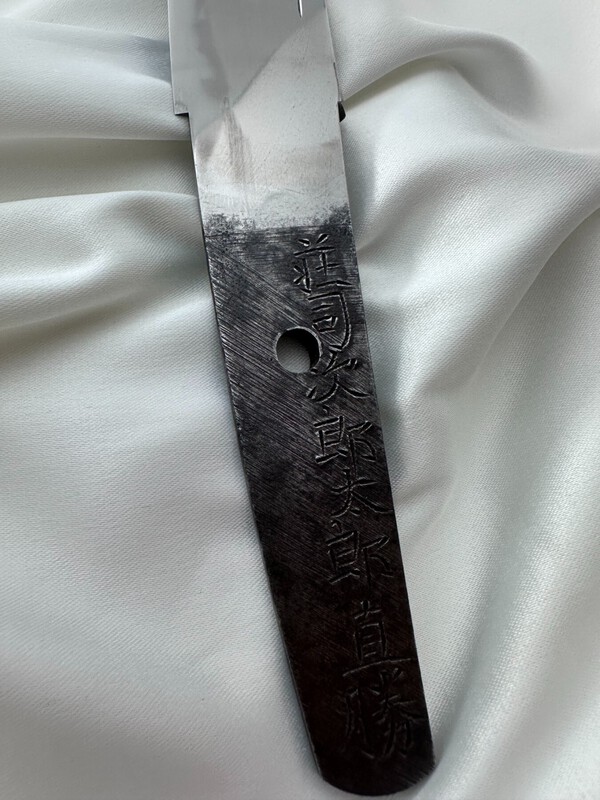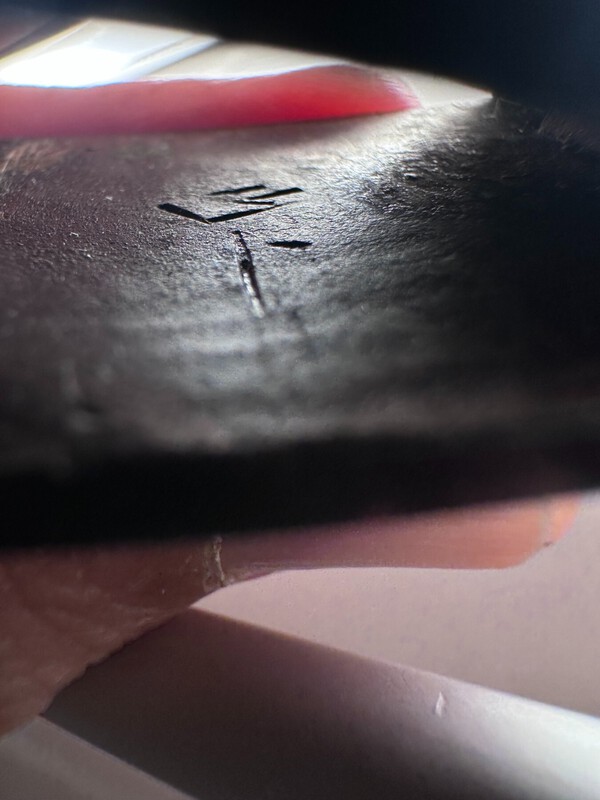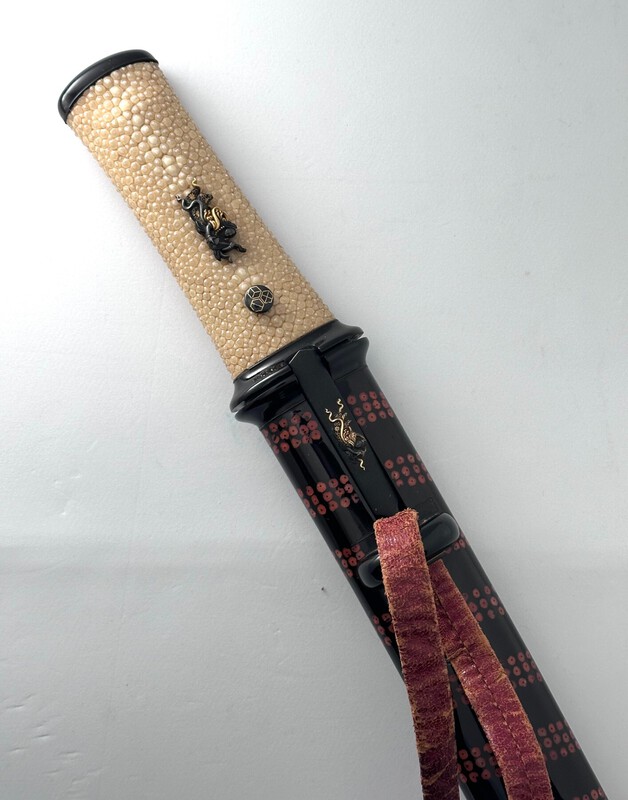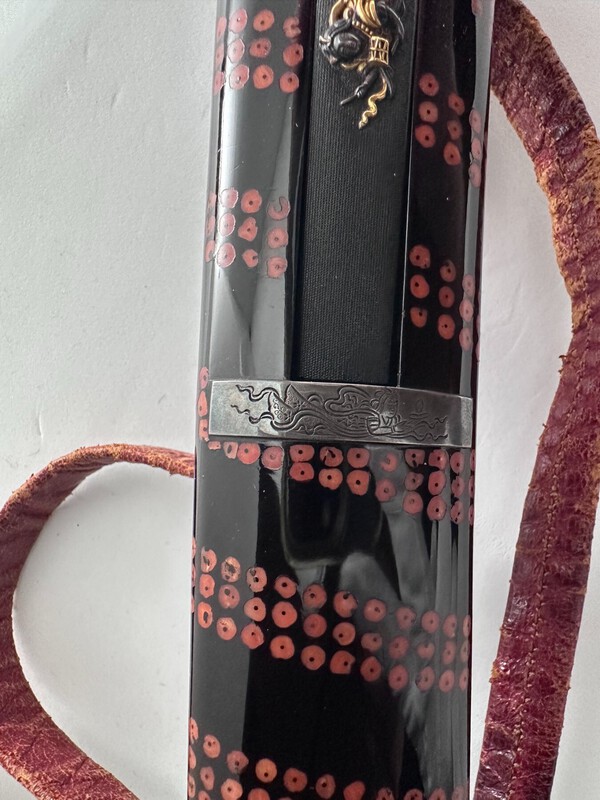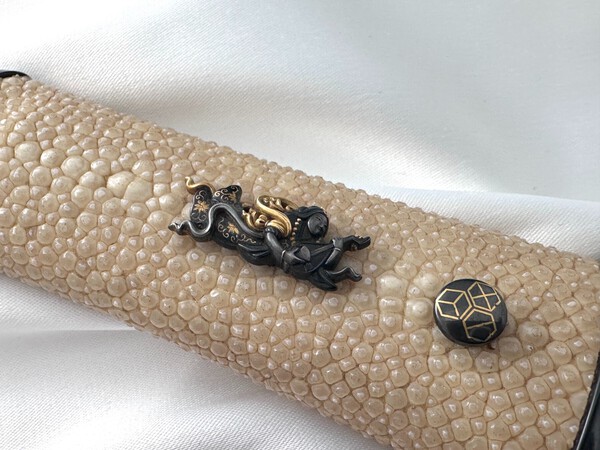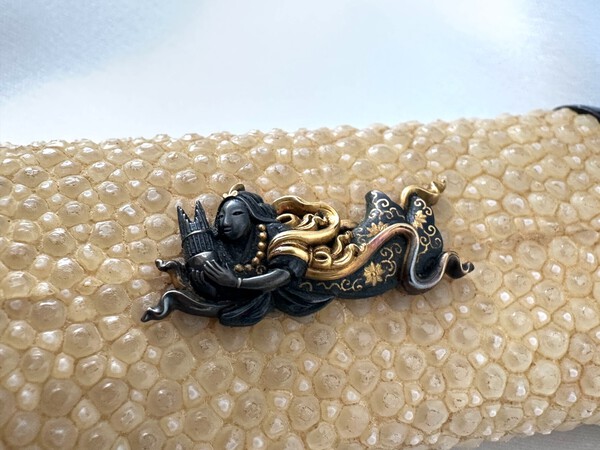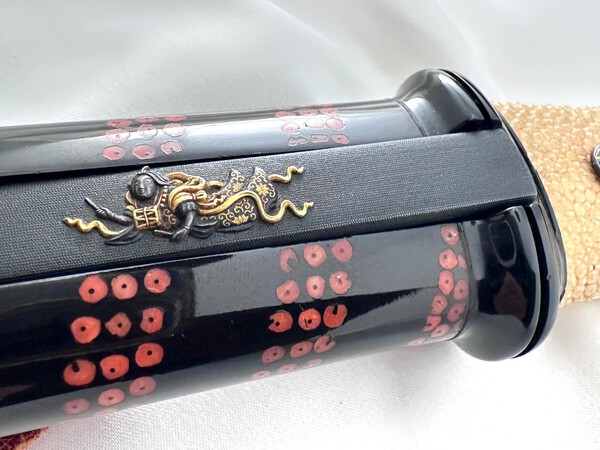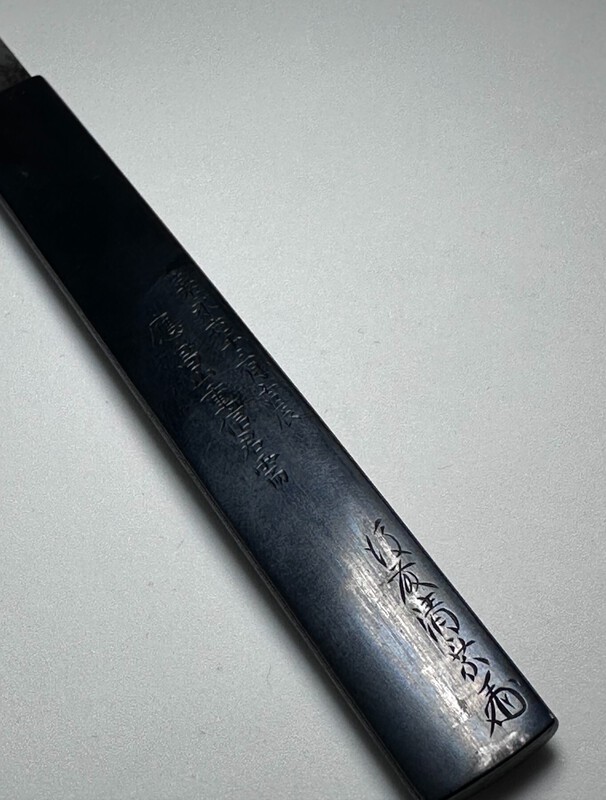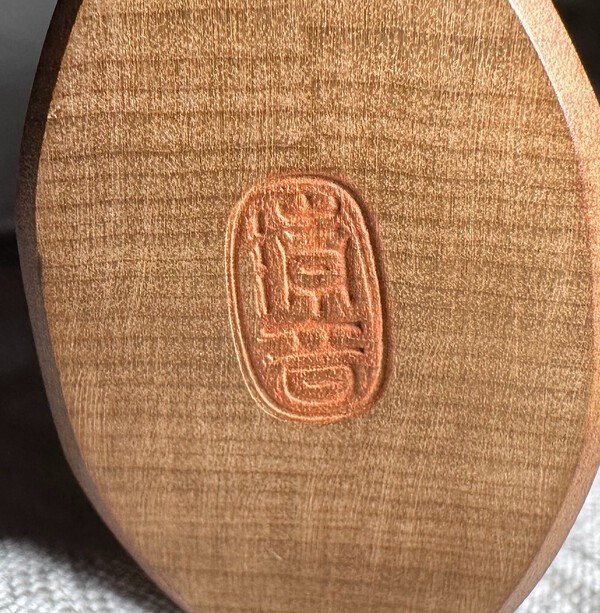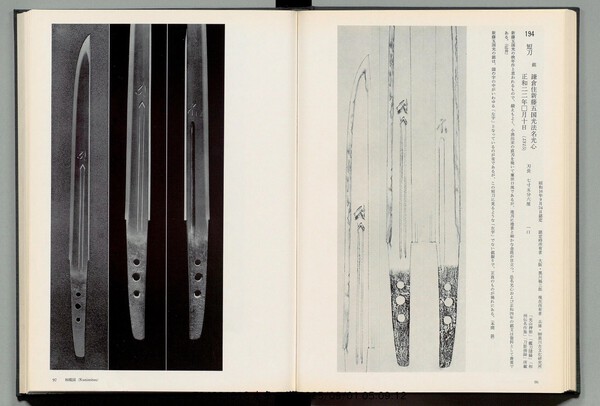-
Posts
543 -
Joined
-
Last visited
-
Days Won
9
Okan last won the day on October 19
Okan had the most liked content!
About Okan

- Birthday 06/26/1980
Profile Information
-
Gender
Male
-
Location:
UAE
Profile Fields
-
Name
Okan
Recent Profile Visitors
6,100 profile views
Okan's Achievements
-
Thank you, Moriyama-san!
-
Okan started following Mei inside habaki
-
Signed as: 莊司次郎太郎直勝 嘉永六年二月日庇畠山氏需造之 Shōji Jirōtarō Naokatsu Made by order of the Hatakeyama clan(family) in February, 1853 (Kaei 6)
-
Hi, Can anyone help me figure out what it says? Seems like 2 kanji? If so, second one is ト perhaps? Thank you
-
-
@Spartancrest Good old deities..(Hiten) @Steve Waszak I'm glad you liked it! @Curran Thanks! Loved your quiet lion comparison—really captures its presence. I’ll make sure it’s well cared for. I'll share some more details soon.
-
I’d appreciate it if someone could kindly double-check this. 清音 ?
-
Thank you, Axel. The koshirae doesn’t have papers, and to be honest, I haven’t decided yet whether it needs one. (It'll get tokubetsu %100) And yes, the stamp is on the bottom of the shirasaya — part of the ongoing research.
-
Hello all, I’m pleased to share something that I’ve gave a lot of effort to get. It’s a special order Naokatsu Wakizashi. Although the name is inscribed, I don’t want to give so much information about the person who ordered it as my research is still going on. All fittings are made and signed by 7th gen Goto Seijo, and whole set is original to the blade(possibly sageo as well), bearing the name of the same individual - been preserved in perfect condition for exactly 172 years. I’m not sharing detailed images of the blade yet, as it needs to be photographed in a better setup. And at present, it is not for sale. Hope you enjoy it.
- 15 replies
-
- 26
-

-

-

-

-
Dear John, I'll try to share it today. What made you think it has a koshirae :D
-
- 1 reply
-
- 1
-

-
I believe the use of “posthumous” was just a simple translation error. I’ve checked the original text again, and it does not say anything about “after death.” Other sources suggest that Kunimitsu likely took Buddhist vows while still alive, and the work dated 1315 may have been made by him personally, maybe his last one. Some sources also suggest that the blade is a work from his advanced age. There are no clear records of the date of his passing, and the blades bearing dates later than this (1319, 1321, 1329, etc.) are attributable to Kunimitsu II. Overall, I believe all of these attributions are best guesses based on the available evidence, so it’s best to wait for the sword to be polished, which may reveal more definitive information..
-
Dear Lewis, This is a research study by Nobuo Ogasawara, conducted for and published in the Tokyo National Museum magazine in 1981. Although I made some small corrections, the translation(AI assisted) still contains some errors, but it should give you the general idea. "" The inscriptions of Shintōgo Kunimitsu, as can be seen from the rubbings presented here, each display individual differences. Broadly speaking, example 1 can be regarded as a representative inscription of the hidari-ji hokan style. Examples 2, 3, and 4 are similar to this, with example 4 bearing the latest date of Gen’ō, and is sometimes regarded as the work of a second generation. What is common among these four pieces is that the forging exhibits a well-developed ko-itame grain pattern, the ji-nie is present, and the blade shows clear ji-kage, resulting in a bright and lively jitetsu. The hamon is a straight temper line (suguha) with well-developed ko-nie, and it features pronounced kin-suji, demonstrating lively activity and excellent workmanship. In contrast, examples 5 and 6, dated to the Kagen and Tokuchi eras, show inscriptions that are finer and weaker in appearance. Despite being early in date, they convey the impression of late-period inscriptions. In terms of inscription style, they are clearly different from examples 1 through 4. Furthermore, the forging shows a pronounced masa-gokoro (straight-grain tendency), and compared to the previous four blades, the nioi-guchi of the hamon is tighter, there is less activity within the ha, and the fukura (blade curvature near the edge) tends to sink. Stylistically, examples 12 and 13 are similar, though their engraving chisels (tagane) are finer and the inscription style differs slightly. Examples 7 and 8, as well as those bearing the Buddhist posthumous name Kōshin, do not use the hidari-ji style, and example 7 also lacks the hokan (north-crown) character. These are considered a different type from examples 1 through 6, though stylistically they resemble 5 and 6. Examples 9 and 10 have overall solid inscriptions, with the third stroke of the ko in Mitsu rendered as a plain “tsu” rather than the variant “フ”. Example 9 features a midareba (irregular hamon) with pronounced kin-suji, and the forging shows a raised texture. Example 10 has an ordinary straight suguha. Example 11 differs greatly in inscription style; although it uses the hidari-ji hokan style, it shows unique characteristics not shared with the others. If anything, opinions have shifted toward a broader view that the pieces in question may date from after the inscription bearing the Buddhist posthumous name Kōshin in Shōwa 4. In that case, the works of Bunpō, Gen’ō, and Genkō would be considered second-generation. However, when it comes to pieces with only the two-character inscription, such as the famous Aizu Shintōgo Kunimitsu, it becomes difficult to determine whether they belong to the first or second generation. A detailed examination of Shintō Gokunikimitsu inscriptions shows that each character varies slightly, making it virtually impossible to estimate the production date based solely on a two-character inscription. Nonetheless, in addition to the common inscription style featuring the “left-character” with a north-crown (hidari-ji hokkan), there are several distinct variants: 1. Those executed with a fine chisel (hoso-zan), where the inscription appears somewhat larger (though in reality almost the same). Examples include works dated to Kagen 4 and Tokuchi 3 (Important Cultural Properties), and, although tachi, the famous Mutsu Shintōgo is included in this group. 2. Those not using the left-character north-crown, such as pieces in the Tokyo National Museum or those bearing the Buddhist posthumous name Kōshin. 3. Those where the “kuni” character is a left-character but the “mitsu” character does not have a north-crown, or where the third stroke of “mitsu” is unusually firm, as seen in the famous Ran Shintōgo. 4. Those with large inscriptions and a firm, rigid style, such as the famous Kojiri Gokunimitsu and the tachi passed down from the Tokugawa family. The four types described above differ from the typical left-character north-crown (hidari-ji hokkan) inscriptions. Based on these differences, it can reasonably be concluded that the inscriptions were not cut by a single hand. Rather than strictly distinguishing first and second generations, it is more plausible to view the head smith Kunimitsu as a single master while Shintō Kunimitsu operated as a collective workshop consisting of multiple smiths. Naturally, certain stages of sword-making required a lead smith, and there may have been several lead smiths working simultaneously, making the finished products the result of collaborative effort. On a larger scale, tasks such as forging, finishing, hardening, and polishing were likely divided among specialists. Although it is difficult to determine the precise scale of the Shintogo Kunimitsu workshop in Kamakura, it is reasonable to assume that multiple smiths inscribed the Kunimitsu signature during the lifetime of the head master. ""
-
Dear Lewis, Here is the one with the Koshin mei that Jussi already shared with us. 鎌倉住新藤五国光 法名光心 - Shintōgo Kunimitsu, residing in Kamakura, Buddhist name Kōshin 正和四年 口月十日 - 10th day of [unknown month], Shōwa 4 (1315) Honma's note is important: “The signature of Shintōgo Kunimitsu usually has the character for ‘kuni’ (国) written in the so-called ‘left-hand character’ style. However, as seen in this tantō, there are rare cases where the mei is not in that form, and yet they are genuine. (Comment by Honma)”
-
Hello everyone, Okan Asik here. I'm based in Dubai and specialize in authentic Japanese swords and fittings, which I source directly and exclusively from Japan. Some of you may already know me and my story. My interest in Japanese swords began many years ago as a collector and researcher. After moving to Dubai a few years ago, I decided to go full-time and build my life around Nihonto. Since Japan doesn’t ship swords directly to the UAE, I personally travel to pick up each piece. For me, this isn’t just business; it’s about placing these works of art in the hands of those who will truly appreciate and take care of them. I look forward to sharing items with you all on the forum. Warm regards, Okan PS: My website will be up in a few months(hopefully), but in the meantime I’m going to share items and updates on social media so please follow! facebook.com/ginzamaru.dubai
- 3 replies
-
- 12
-

-

-



